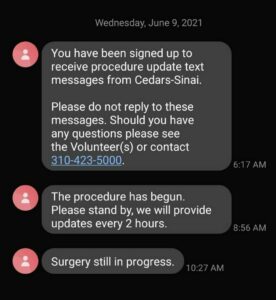


My family’s journey through a variety of healthcare and hospital systems this summer began with some pretty poor communication, or what we often refer to as “poor bedside manner.” In our case, the manners—and often lack thereof—began well before the bedside.
After getting off the table and dressed after some chest scans, my mom emerged into an industrially lit hallway. There—with other doctors and patients walking right by—the cardiologist casually stated, with little emotion, that based on her results, she would inevitably need surgery. And a big one at that: open-heart surgery. That day, she was on her own at her appointment—what she assumed would be a pretty routine one—and later needed to drive home carrying the weight of that information.
Healthcare is a system shrouded in mystery that often leads to frustration for two reasons. First, it rarely meets users where they are and it’s only slowly responding to (and leveraging) the digital world. How often I find myself in waiting rooms, filling out paper forms, that someone behind the counter will need to, moments later, type back into the computer system. Second, users must wade through technical terminology across the entire experience, from check-in at an office to follow-ups with insurance companies. After my mom’s startling conversation, we were thrust into the world of cardiology: angiograms, ORs, telemetry, sternotomies, and all sorts of words we could hardly pronounce, let alone grasp in our shock.
From the outside peering in, the world of medicine appears to be a complex machine built on strict adherence to methodical practice, triage, and order. When catapulted inside as users—merely temporary visitors to the system—there were no clear next steps, workflows, or confirmations that we were moving in the right direction. Nothing felt personalized to my mother’s case, and inconsistent feedback was rampant. Luckily for my family however, we found a beacon of clear communication and trust. Enter Cedars-Sinai hospital in Los Angeles.
After extensive online research and rabbit holes of cardiovascular surgery Facebook groups, we discovered a surgeon that specialized in my mother’s particular heart valve condition. Despite the surgeon’s location on the opposite coast of the country, her clear communication style and her team’s ability to adeptly organize and transfer medical files, drew us to consider traveling far for surgery. The surgeon provided clear answers on postoperative outcomes and quality of life, and most importantly, conveyed genuine patience and empathy via video chat appointments; we were already sold. We didn’t yet know just how comfortable Cedars would make us feel—and how critical this would be to the experience.
Arriving for a pre-op appointment just a day before surgery, our family unit quickly felt informed and familiar with the hospital. This was due to Cedar’s unwavering belief in the power of communication and empathy. I’d argue their “products”—signage, brochures, digital reminders, customer service—were thoughtfully designed for their users. We were handed print-outs with particulars on my mom’s 5:00 a.m. arrival for operation, along with a general guidebook on cardiovascular surgery: what to expect before and after.
In the midst of an overwhelmingly unfamiliar situation, something felt recognizable. My UX writing brain turned on:

After a sleepless night, we said quick goodbyes to my mom before she would endure a 5-7 hour surgery. Cedars thoughtfully considers patients’ mental health and allows a visitor to stay with the patient throughout the majority of preoperative prep and dressing, so that they feel less alone.
When the anesthesiologist came in to take over, my mom left our sights and the long waiting period for me and my dad commenced. Thankfully, we began receiving notifications within the hour of leaving her bedside. At check-in, the nurse takes down family members’ phone numbers and you’re automatically signed up to the notification system.

Rather than staring down a black hole, the world of waiting felt more structured because Cedars-Sinai set clear expectations: “We will provide updates every two hours.” This feedback loop was critical to our wellbeing and most likely helps Cedars avoid fewer panic attacks occurring in their waiting rooms.
Nothing can prepare you for the emotions that come with waiting apprehensively for news of a loved one, then seeing them wrapped in wires, hooked up to monitors leading to unfathomable beeps and lines across the screen. I found my mom hosed with a ventilator, her hands restrained to the sides of the bed to stop her from pulling it out of her throat. A nurse had tenderly pulled back and tied up her hair so it was out of her face. The past two years marked by the pandemic have seen an overwhelming amount of people in this position. We spent the next week in the Cedars-Sinai Cardiac ICU.
I soon met the people I now respect and admire the most: the doctors, fellows, nurses, social workers, assistants, and custodial team that ensured my mom recovered from intensive heart surgery. Though diverse by every measure, I recognized the same level of care and clear communication present across the entire staff. They were phenomenal: compassionate, competent, and confident in what they came to work to do every day. I met a host of nurses at their shift changes, a social worker who told my mom she didn’t look like she even had surgery (we loved to hear it), a security man who helped me with directions, and a surgical fellow who came in with a gigantic needle that looked more like a prop than something to be realistically used (turns out, that’s how nerve blocks are actually administered). Every single Cedars employee was patient and unhurried in conversation, selective in their word choice, and professional, yet genuinely warm.
As my mom’s vitals normalized and I became more familiar with the intricate medical complex, I started paying attention to the language in the signage, something that either bolstered the general voice and tone of the staff or acted as constant reminders that might have made all the difference.

Your words and behavior matter. Cedars-Sinai is a place of healing where everyone deserves to be treated with courtesy, respect, and kindness. Please take a deep breath and be mindful of the energy you are bringing to this space.
This notification, though simple, was straightforward and consequential. It reminded the staff that the sights they see every day were not commonplace to patients and their families. I began to notice a rotation of these reminders across all the room monitors and nurses’ stations. Along with these more sweeping reminders, there were some news notifications as well.

These all held the same common message: your words matter. Take a deep breath before interacting with a patient, ensure you use proper building names so visitors don’t feel as overwhelmed by the massive acreage of the hospital complex.

While some screens were written with the patient in mind, many of the communications were specific to staff concerns. Yet the communications team saw fit to utilize the same quality of messaging to inform their staff. The voice was direct, yet warm. The screens are scannable and straightforward. Images are accompanied by alternative text. They demonstrate the extent to which Cedars-Sinai values communication. We rarely see internal messaging examples—most especially outside of the tech industry—so well-designed, branded, and more than anything, so thoughtfully written.

Though I cannot pretend to understand the extent of the hospital’s ways of working, their employee relationships, etc., I feel that these screens invite the hospital community—specifically their employees—into broader conversations and note long-term considerations, like annual cost-effectiveness. Perhaps the true value of the messaging cannot be felt without considering its alternative: a Microsoft word bold text reminder, “Do not dispose of monitoring items! These are expensive pieces of equipment!” I’m sure that would make employees and patients alike feel valued.
Over six days, we had become intimately familiar with the quickest routes to caffeination, thanks to excellent wayfinding and Starbucks icons. My mom was doing well—she could walk a couple laps around nurses’ station now, and thankfully, her pain level was manageable. Walking out of the ICU one afternoon for a coffee, a sign caught my eye in the main lobby. It reminded visitors that Cedars was a space of healing, where lowered voices and awareness of others’ situations was not only appreciated, but requested. In their relentless accommodation for patients’ families, it struck me just how dedicated Cedars was to cultivating a calm space for healing.
This sense of appreciation was not unfamiliar to me anymore. Just a few days before, the nurse who admitted my mother to the ICU post-surgery—and tended to her most awful hours of recovery between nerve blocks and ventilators—told me, “I know how overwhelming and scary this must be for you, it’s nothing your family is used to seeing. But know that to us, this is all normal. This is our every day. So trust that she’s in good hands and will recover well.” Another reminder: “Your words and behavior matter.”
It was then that I realized it was one highly designed system. Cedars-Sinai had thoughtfully crafted an intricate, yet expansive system of communication that spread from posted signs to conversations with staff, all with one common message: We are empathetic to your situation. We’re going to help you get through what you’re going through. We know it’s a group effort between the hospital, the patient, and their family.

My family’s experience at Cedars-Sinai showed me holistic service design at its finest. It moves beyond the basics of empathy and into the more consequential (and trickier to get right) tenets of dignity, respect, and compassion. The hospital’s mission and message of compassion was present across all touchpoints, from their website to their people. This is the kind of thoughtful design we’ve come to expect of social media and the latest shaving subscription box. But we don’t expect it, let alone demand it, from arguably the most important sectors of our life. It’s disheartening to realize that I admire Disney World’s incredible operational design, but have never thought to ask for it from the institutions that have the power to save or change lives.
This unwavering commitment to caring for patients and their families was felt on all levels, unlike anything I’ve encountered in the medical world before. I feel lucky that we had the ability to travel to California for my mother’s procedure, and feel even more so frustrated that this level of care isn’t standard across the country.
Back home and healthy now, my mom is excelling in cardiac rehab and a lot has returned to normal. It’s difficult to focus on anything but my relief, and feeling grateful to the fantastic surgical team and nursing staff that—without hyperbole—may have saved my mother’s life. More than ever before, I also feel the extent of what communication and service design—and its practitioners—can do. Cedars goes beyond writing well; they employ content strategy to set up systems of communication that make it easier on internal and external readers. They convey care and compassion that can actually touch readers through their words—and impact the way we heal.
Sammie is a Senior UX Writer for Vogue at Condé Nast and an instructor at UX Writers Collective. Connect with her on LinkedIn.

Explore our content design and UX writing training:
Get our weekly Dash newsletter packed with links, regular updates with resources, discounts, and more.
